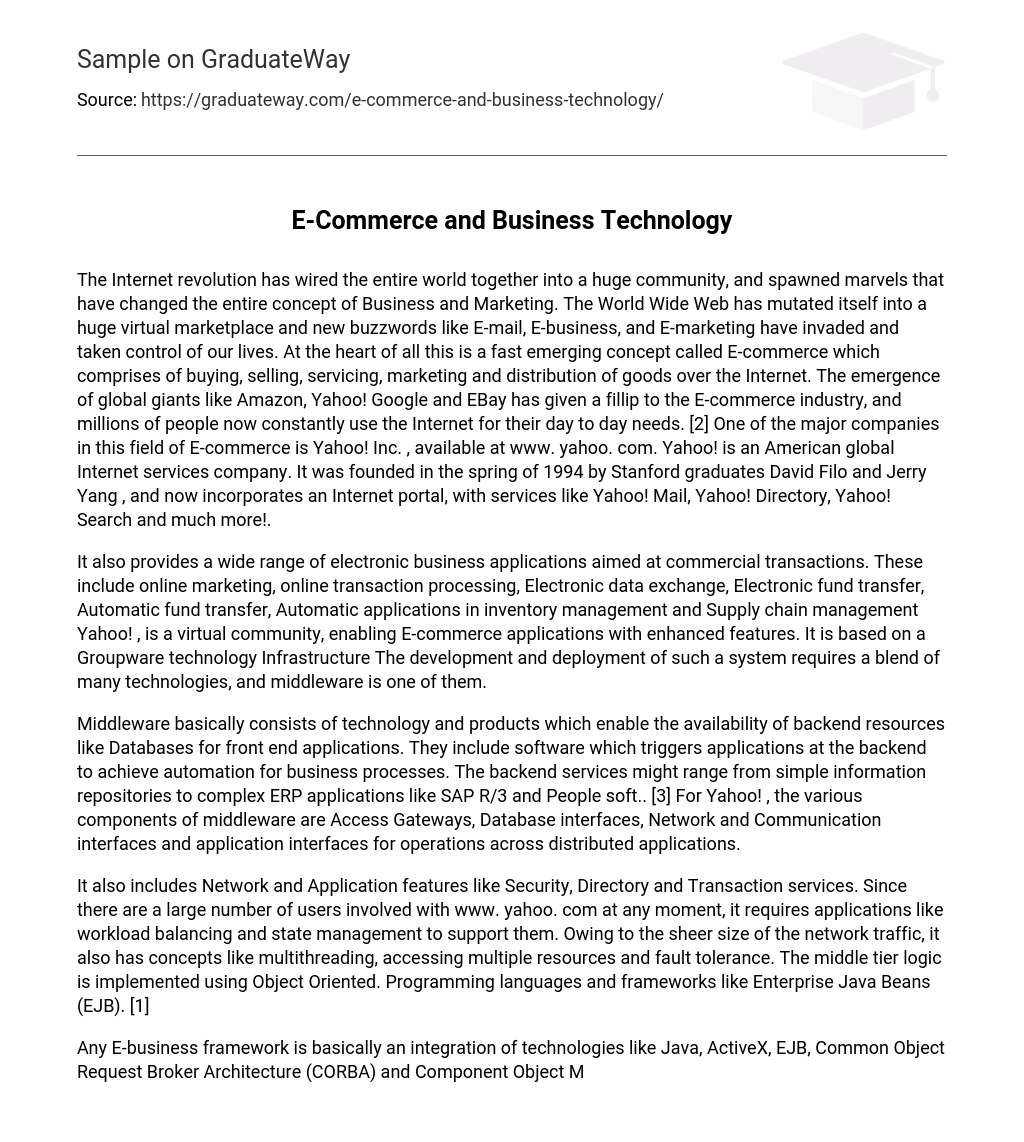The Internet revolution has wired the entire world together into a huge community, and spawned marvels that have changed the entire concept of Business and Marketing. The World Wide Web has mutated itself into a huge virtual marketplace and new buzzwords like E-mail, E-business, and E-marketing have invaded and taken control of our lives. At the heart of all this is a fast emerging concept called E-commerce which comprises of buying, selling, servicing, marketing and distribution of goods over the Internet. The emergence of global giants like Amazon, Yahoo! Google and EBay has given a fillip to the E-commerce industry, and millions of people now constantly use the Internet for their day to day needs. [2] One of the major companies in this field of E-commerce is Yahoo! Inc. , available at www. yahoo. com. Yahoo! is an American global Internet services company. It was founded in the spring of 1994 by Stanford graduates David Filo and Jerry Yang , and now incorporates an Internet portal, with services like Yahoo! Mail, Yahoo! Directory, Yahoo! Search and much more!.
It also provides a wide range of electronic business applications aimed at commercial transactions. These include online marketing, online transaction processing, Electronic data exchange, Electronic fund transfer, Automatic fund transfer, Automatic applications in inventory management and Supply chain management Yahoo! , is a virtual community, enabling E-commerce applications with enhanced features. It is based on a Groupware technology Infrastructure The development and deployment of such a system requires a blend of many technologies, and middleware is one of them.
Middleware basically consists of technology and products which enable the availability of backend resources like Databases for front end applications. They include software which triggers applications at the backend to achieve automation for business processes. The backend services might range from simple information repositories to complex ERP applications like SAP R/3 and People soft.. [3] For Yahoo! , the various components of middleware are Access Gateways, Database interfaces, Network and Communication interfaces and application interfaces for operations across distributed applications.
It also includes Network and Application features like Security, Directory and Transaction services. Since there are a large number of users involved with www. yahoo. com at any moment, it requires applications like workload balancing and state management to support them. Owing to the sheer size of the network traffic, it also has concepts like multithreading, accessing multiple resources and fault tolerance. The middle tier logic is implemented using Object Oriented. Programming languages and frameworks like Enterprise Java Beans (EJB). [1]
Any E-business framework is basically an integration of technologies like Java, ActiveX, EJB, Common Object Request Broker Architecture (CORBA) and Component Object Model(COM) using applications like Hyper Text Transfer Protocol (HTTP), SQL, Java Database Connectivity (JDBC), Open Database Connectivity (ODBC) and Common Gateway Interface (CGI) to make ends meet. The E-Commerce system generates a number of tiers to support all these applications. It also creates an enhanced graphical environment, and supports diverse client-side environments like Java and Activex.
These organizations now provide more diverse content and more robust services for the seamless integration of applications and data throughout the Internet. [3] Other companies which have developed their e-commerce sites are www. ebay. com, www. amazon. com, www. google. com, www. moneybookers. com and www. paypal. com . These sites have been milestones in the history of the Internet, providing greater efficiency and convenience to all its users. The increasing dependence of people on these e-commerce websites has heralded a new era where the Internet has become the one-stop-shop for all needs!!
References:
[1] Abhijit Chaudhury, Jean-Pierre Kuilboer (2002) “e-Business and e-Commerce Infrastructure, Technologies Supporting the E-Business Initiative”: McGraw-Hill [2] Dr. Michael Rappa (2007) “Business Models on the Web” Retrieved March 8, 2007 from Managing the Digital Enterprise, Web site: http://digitalenterprise. org/models/models. html [3] “E-Commerce Systems Technology Infrastructure” Retrieved March 8, 2007, from Ceskoslovenska sekce IEEE Web site: http://www. ieee. cz/knihovna/Rajput/Rajput085-ch06. pdf





